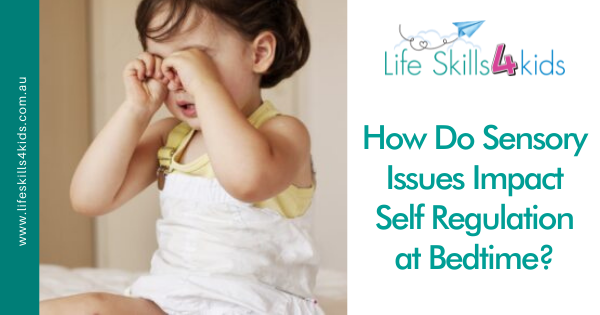Sensory Issues and Self Regulation at Bedtime
Bedtime can be a difficult time of the day for kids and when your child has sensory issues, that difficult time can multiply over and over again. The thing is, sensory issues can exacerbate what seem like minor irritations into major problems when it comes to coping with bedtime for your young person.
There are so many factors and disruptive noises, clothes labels, textures of bedding, temperature of their room, bodies that want to keep moving, background sounds of people talking or the TV – all of these can have a massive impact on kids with sensory issues being able to self regulate and calm themselves down enough to go to bed and stay in bed, let alone sleep.
As we all know, sleep is a vital component in our wellbeing, in keeping ourselves in a good place and in giving our bodies chance to rejuvenate and provide us with enough physical, emotional and mental energy for the day ahead.
So, if you have a child with sensory issues who needs help to fall asleep, or may be fine when they go to bed but then wake up at 2am to “play”, or always wake up like a bear with a sore head – then that situation will not only impact your child’s ability to cope with life, it will affect your whole family on an every day basis.
Once the whole family is affected by sleep deprivation, this causes a snowball effect and can lead to a vicious downward spiral for everyone involved in their ability to be able to function, especially the kids who has sensory issues in the first place.
So, as a parent, how can help your kid with sensory issues to be able to cope with the routine of bedtime on a daily basis?
Sensory Tools & Strategies that a Positive Impact on Bedtime
Essentially, this will be a trial and error process as all of our kids with sensory issues are unique and you will need to build up just the right toolbox for your young person.
You can try a combination of these ideas … and remember, that what works one day, may not always work the next. It is always a good idea to have other sensory tools available just in case your kid is having “one of those days”.
Hearing
- Wearing noise cancelling headphones or earplugs at night can be helpful for some children.
- They are also good for blocking out sounds that you and I don’t even notice and can do little to eliminate such as the hum of the freeway or passing traffic, distant trains, loud neighbours or even crickets.
Other kids are not quite as sensitive but do need to have white noise to sleep. You can try items like fans or a sound machine that has a variety of different options, it is soothing as well as providing white noise and makes sleeping much easier.
Proprioception (Deep Pressure)
- A weighted blanket or heavy quilt folded up to increase weight and pressure. Weighted blankets provide a sense of safety and security that encourage your child to relax which is exactly what they need to help them fall asleep and stay that way.
- You can also try stretchy sheets which will provide a similar effect to a weighted blanket.
- Tight fitting pajamas or compression clothing at bedtime are great too, I work with a young person who cannot stand the feel of bedding on her, but settles well when she is wrapped in several fleece throws (she needs these tightly wrapped around her).
- Deep pressure touch to arms and legs, also called hand hugs or squeezes.
- A cuddle swing or hammock swing may be used as a cozy nest for sleeping. This is only appropriate for children old enough and able to maneuver around in the swing throughout the night and get in and out independently. The swing should hang close to the floor for safe and independent use.
- Gentle, rhythmical, and linear swinging in a cuddle or hammock swing for at least 15 minutes before bedtime is a great idea.
- Try a rocking chair in a quiet, calm, dark place right before bedtime. If the child is small enough, gentle swinging in a blanket can be very calming.
- A vibrating pillow or hand held massager placed under the mattress for a diffused vibration can be helpful. There are also vibrating mattresses available for purchase.
- Try the “tortilla roll up” in a blanket with added firm pressure (proprioception) from a large therapy ball by rolling the ball over the child’s body .
- Try a large bean bag or pillow cave with tons of pillows and blankets. This can be where the child sleeps, not just before bedtime.
- Encourage joint compression and joint traction activities prior to bedtime, including head compressions and try inverting the head throughout the day and right before bedtime as well.
Touch
- Some kids cannot cope with labels on clothing or certain types of material on their skin
- Equally, the bedding needs to be a texture and material that promotes a positive bedtime experience for your kid
- Most sensory kids prefer soft textures, but the best way is usually to work with your child in picking out fabrics that are comfortable to them
Visual
- Some children need it to be completely dark in order to fall asleep while others need to have a nightlight.
- It’s a good idea to use a dimmable night light because that way, they can adjust to the amount of light they are comfortable with.
Smell
- Try applying magnesium oil to the bottom of the child’s feet at bedtime.
- Some parents swear by putting lavender oil or another calming essential oil in a diffuser. You can also use lavender oil and epsom salts in a warm bath before bed
Taste
- Provide an oral sensory tool, for example a chewy
- Some kids find particular types of toothpaste help within their bedtime routine – experiment with tastes and textures, to see what your child prefers
Bedtime Routine
Bedtime routines are helpful for all kids, but are especially so for sensory kids. Routines help their mind and body recognise that it’s time to start winding down and preparing to sleep. These routines also become helpful when they face changes such as traveling. Traveling can be difficult, but if you can bring along part of the routine like teeth brushing followed by a story, then they still have a sense of familiarity to help them cope.
Kids will also appreciate having their own custom-designed space. They can help you pick out blankets, pillows, soft toys and styles of bed which will help them. Sensory kids often like to feel enclosed, for example, sleeping on the bottom bunk bed or being surrounded in a canopy bed.
Other Important Tips:
Be sure to offer a variety of sensory activities throughout the day. Meeting your child’s sensory needs during the day will positively impact your child’s ability to fall asleep at night.
It is up to you to be a “sleep detective” and find out what works for your kid! Try lying in their bed in the dark and using your senses to troubleshoot what issues there may be. Is there any type of noise that may be bothering them? Are the sheets scratchy? Are the walls painted a bright colour or is there too much clutter in the room? How is the temperature in the room? Is there a smell?
Extra tips include:
- Limit screen time during the day and cut it off completely in the hour or two before bedtime. This will improve their body’s ability to fall asleep
- It can be hard to find the right combinations and conditions to help your sensory kid find rest, but don’t give up, that combo is out there. And you can try to have fun finding it too. Anything to relieve the pressure and stress is a step in the right direction.
- This sleep smoothie contains some natural sleep help and most kids will happily drink it.
- Nutrition is an important piece of the sleep puzzle. Ensure that your child has a well balanced diet, limited sugar and no caffeine.
If you’re looking for more practical strategies that work for your child’s everyday sensory needs for things like picky eating, refusal to wear certain clothing, difficulty self-regulating, meltdowns, and challenging behaviours, have a look at our article on finding out whether your kids has sensory issues.
Written By Deb Hopper, Occupational Therapist
The Life Skills 4 Parents Membership Hub
Your one-stop-shop for everything you need to create a peaceful, structured and purposeful home.
The Program is designed to take you step-by-step through tried and true strategies to:
- Make mornings and nights easier.
- Reduce your anxiety and stress.
- Reduce the drama of family life.
The Life Skills 4 Parents Membership program will provide you with:
- 1 x LIVE Monthly parent coaching group call via ZOOM
- Access to Life Skills 4 Parents online education portal with new trainings added monthly
- Exclusive FB group with 24/7 access to our parent community and our OT team for support on the go
- Growing library of 10-minute self-paced parenting mini trainings in our Life Skills4Parents portal


